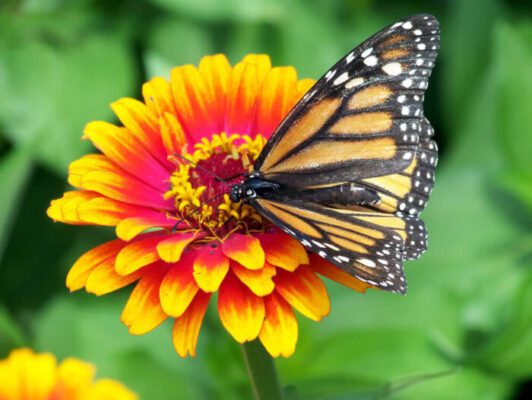Butterflies bring beauty and wonder to any garden. Their brightly colored wings and gentle fluttering flight delight people of all ages. You can easily turn your yard into a butterfly haven by providing the elements these insects need to thrive. With some planning and planting, your landscape will soon be filled with many different butterfly species visiting regularly. In this article we talk about How to Create a Butterfly-Friendly Garden In 2024.
Table of Contents
Choose a Sunny Location
Butterflies are cold-blooded and rely on external heat sources to raise their body temperature so they can fly. A location that receives at least 6 hours of full sun each day ensures butterflies have enough warmth to be active. South or west-facing spots that avoid cold winds are ideal. For gardens in cooler climates, situate the butterfly habitat along the side of a building or fence that absorbs warmth from the sun.
Provide Shelter
Butterflies need protected areas to rest overnight or when the weather turns foul. Nearby trees, shrubs, and tall plants give shelter from wind and rain. Structures like garden sheds, large birdhouses, or even a children’s playhouse with openings provide additional refuge. You can also place large branches or pieces of untreated wood against supports in a sunny corner.
Incorporate Host Plants
Host plants provide the food butterfly caterpillars need to grow and develop. They lay eggs exclusively on the leaves of certain native plant species. Some examples of good caterpillar host plants include:
- Milkweed – Monarch butterflies cannot survive without this crucial plant. The foliage feeds the caterpillars while the flowers supply nectar to adults.
- Passion flowers – Gulf fritillary butterflies rely on maypop and other passion flower varieties to raise their young.
- Sundials or lupines – The caterpillars of blue butterflies have an appetite for these plants.
Check with local nurseries or extension services about the best regional host plants for caterpillars. Be sure to add several to your garden design.
Include Nectar Plants
While the caterpillars munch on leaves, adult butterflies sip nourishing nectar from flowers. Certain blooms seem nearly irresistible to these winged beauties. Some top butterfly nectar plants include:
- Coneflowers – The bright petals and sweet nectar of purple coneflowers, black-eyed Susans, and related Rudbeckia attract many butterfly species.
- Lantana – Available in a rainbow of colors, lantana flowers prolifically from spring through fall. Butterflies flock to their small blossoms.
- Verbena – Low-growing verbena makes an excellent border plant. It blooms repeatedly if spent flower clusters are removed.
- Butterfly bush – As its name suggests, butterflies cannot resist the nectar-laden flowers of butterfly bush shrubs. Be sure you choose only sterile varieties that won’t spread invasively.
- Zinnias, marigolds, cosmos, and other annuals – Bright single flowers with short flower tubes are best for butterflies. Go for heirloom varieties instead of showy double flowers.
Plant nectar flowers in large swaths of color for highest visual appeal. Mass plantings also allow butterflies to move easily between plants.
Provide Water
A shallow water source like a bird bath, water garden, or pebble-filled tray lets butterflies sip moisture to supplement their liquid diet. Use stones within the water feature for safe perching. Add a few damp stones or a sponge to give butterflies needed minerals. Change the water daily to prevent breeding mosquitoes. Site the water source near nectar flowers and protected areas.
Avoid Pesticides
Butterflies and caterpillars are extremely sensitive to many common garden pesticides and weed killers. Even natural or organic formulations can be toxic to these beneficial insects. Avoid using any chemical treatments in your butterfly garden space. Tolerance of minor damage to host plants is essential to support butterfly populations. Hand pick large caterpillars if they begin severely defoliating plants.
Add Mineral Rich Soil
While butterflies get most liquid nutrients from nectar, they also seek minerals from mud puddles, manure piles, tree sap, and other earthy sources. Place a shallow pan filled with damp sand or fine soil in a secluded spot of your habitat. Mix in a small amount of aged compost for essential salts and minerals butterflies crave.
Wait for Visitors
With a well-planned butterfly friendly garden in place, now comes the fun part – waiting for your new residents to arrive! It may take a few weeks for butterflies to discover the habitat, food sources, and shelter you created just for them. But once they do, you’ll love observing the aerial dance and brilliant colors of your butterfly visitors all season long. Adjust plantings as needed to determine the flowers and host plants preferred by butterflies in your area. Then relax and enjoy watching your new garden friends fluttering gracefully through the landscape you designed just for them.
Creating a dedicated space filled with butterflies offers many rewards for gardeners who enjoy watching wildlife. A successful habitat garden thrives on native plants suited to both caterpillars and adult butterflies. With some thoughtful design features added, your yard can soon transform into a beautiful butterfly paradise that brings joy for years to come. The fluttering wings, amazing metamorphosis, and gentle nature of butterflies will make time spent in your special garden a treasured memory. I sincerely hope you find this “How to Create a Butterfly-Friendly Garden In 2024” article helpful.

Holding a Ph.D. in Botany and boasting over 15 years of experience in horticulture and plant science, our author stands as a top authority on plant care and gardening. Their dedication to sustainable gardening practices and thriving greenery shines through on egreenplants.com, where they share their extensive knowledge and personal insights. Whether it’s mastering plant cultivation techniques or offering expert advice on plant care, their guidance ensures gardening enthusiasts receive reliable and actionable information. Follow their green journey on Instagram at @plantsandrocks for more tips and inspiration.

